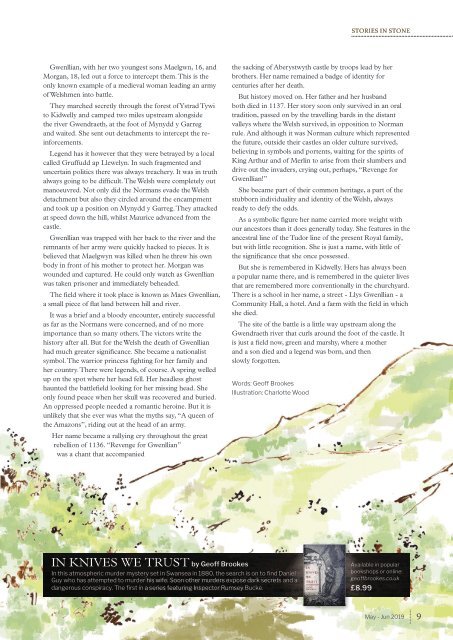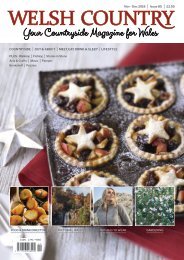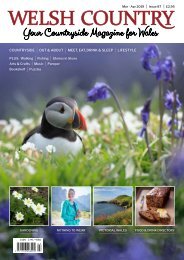Welsh Country - Issue88 - May - Jun 19
This is a complete issue of Welsh Country from May - Jun 19
This is a complete issue of Welsh Country from May - Jun 19
Create successful ePaper yourself
Turn your PDF publications into a flip-book with our unique Google optimized e-Paper software.
STORIES IN STONE<br />
Gwenllian, with her two youngest sons Maelgwn, 16, and<br />
Morgan, 18, led out a force to intercept them. This is the<br />
only known example of a medieval woman leading an army<br />
of <strong>Welsh</strong>men into battle.<br />
They marched secretly through the forest of Ystrad Tywi<br />
to Kidwelly and camped two miles upstream alongside<br />
the river Gwendraeth, at the foot of Mynydd y Garreg<br />
and waited. She sent out detachments to intercept the reinforcements.<br />
Legend has it however that they were betrayed by a local<br />
called Gruffudd ap Llewelyn. In such fragmented and<br />
uncertain politics there was always treachery. It was in truth<br />
always going to be difficult. The <strong>Welsh</strong> were completely out<br />
manoeuvred. Not only did the Normans evade the <strong>Welsh</strong><br />
detachment but also they circled around the encampment<br />
and took up a position on Mynydd y Garreg. They attacked<br />
at speed down the hill, whilst Maurice advanced from the<br />
castle.<br />
Gwenllian was trapped with her back to the river and the<br />
remnants of her army were quickly hacked to pieces. It is<br />
believed that Maelgwyn was killed when he threw his own<br />
body in front of his mother to protect her. Morgan was<br />
wounded and captured. He could only watch as Gwenllian<br />
was taken prisoner and immediately beheaded.<br />
The field where it took place is known as Maes Gwenllian,<br />
a small piece of flat land between hill and river.<br />
It was a brief and a bloody encounter, entirely successful<br />
as far as the Normans were concerned, and of no more<br />
importance than so many others. The victors write the<br />
history after all. But for the <strong>Welsh</strong> the death of Gwenllian<br />
had much greater significance. She became a nationalist<br />
symbol. The warrior princess fighting for her family and<br />
her country. There were legends, of course. A spring welled<br />
up on the spot where her head fell. Her headless ghost<br />
haunted the battlefield looking for her missing head. She<br />
only found peace when her skull was recovered and buried.<br />
An oppressed people needed a romantic heroine. But it is<br />
unlikely that she ever was what the myths say, “A queen of<br />
the Amazons”, riding out at the head of an army.<br />
Her name became a rallying cry throughout the great<br />
rebellion of 1136. “Revenge for Gwenllian”<br />
was a chant that accompanied<br />
the sacking of Aberystwyth castle by troops lead by her<br />
brothers. Her name remained a badge of identity for<br />
centuries after her death.<br />
But history moved on. Her father and her husband<br />
both died in 1137. Her story soon only survived in an oral<br />
tradition, passed on by the travelling bards in the distant<br />
valleys where the <strong>Welsh</strong> survived, in opposition to Norman<br />
rule. And although it was Norman culture which represented<br />
the future, outside their castles an older culture survived,<br />
believing in symbols and portents, waiting for the spirits of<br />
King Arthur and of Merlin to arise from their slumbers and<br />
drive out the invaders, crying out, perhaps, “Revenge for<br />
Gwenllian!”<br />
She became part of their common heritage, a part of the<br />
stubborn individuality and identity of the <strong>Welsh</strong>, always<br />
ready to defy the odds.<br />
As a symbolic figure her name carried more weight with<br />
our ancestors than it does generally today. She features in the<br />
ancestral line of the Tudor line of the present Royal family,<br />
but with little recognition. She is just a name, with little of<br />
the significance that she once possessed.<br />
But she is remembered in Kidwelly. Hers has always been<br />
a popular name there, and is remembered in the quieter lives<br />
that are remembered more conventionally in the churchyard.<br />
There is a school in her name, a street - Llys Gwenllian - a<br />
Community Hall, a hotel. And a farm with the field in which<br />
she died.<br />
The site of the battle is a little way upstream along the<br />
Gwendraeth river that curls around the foot of the castle. It<br />
is just a field now, green and marshy, where a mother<br />
and a son died and a legend was born, and then<br />
slowly forgotten.<br />
Words: Geoff Brookes<br />
Illustration: Charlotte Wood<br />
In Knives We Trust by Geoff Brookes<br />
In this atmospheric murder mystery set in Swansea in 1880, the search is on to find Daniel<br />
Guy who has attempted to murder To his purchase wife. Soon a other copy murders contact expose 01559 dark 372010 secrets and a<br />
dangerous conspiracy. The first in or a series visit featuring www.welshcountry.co.uk<br />
Inspector Rumsey Bucke.<br />
Available in popular<br />
bookshops or online:<br />
geoffbrookes.co.uk<br />
£8.99<br />
<strong>May</strong> - <strong>Jun</strong> 20<strong>19</strong> 9









